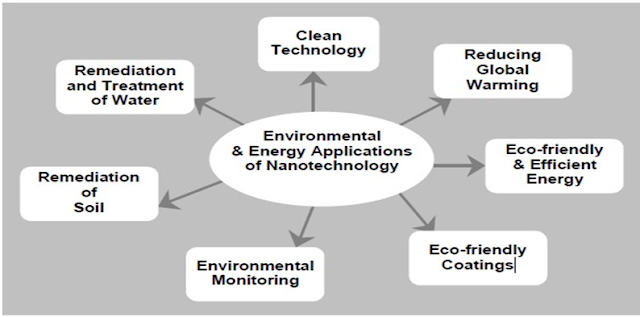Definition: The systematic manipulation of matter on the length scale 1-100 nm to produce useful new engineered structures, materials, or devices.
Nanotechnology (NT) can be defined as the creation and use of materials, devices and systems in a size range of molecular and atomic scale (Nano-scale1).
As it deals with the manipulation of molecules it is also termed as molecular manufacturing. The prefix, “Nano” of Nanotechnology describes a scale nanometer.
${tocify}
Nanometre
A nanometre is thousand millionth of a metre (1 nm = 10-9 m). Some practical examples for knowing the nanometre scale are as follows: It is comparable to -
• 1/80.000 of the diameter of a human hair (Institute of Nanotechnology, 2002) or
• 1/10.000 times the size of a bacteria (Drexler, 1986, p.11) or
• 1000 times smaller than the present micro-metre devices or
• 10 times the diameter of a hydrogen atom.
An early promoter of the industrial applications of NT, Albert Franks, defined it as 'that area of science and technology where dimensions and tolerances in the range of 0.1nm to 100 nm play a critical role'
Challenging Environmental Issues
Legacy Pollutants
– Chlorinated Solvents
– PCBs, PAHs, Chlorinated Pesticides (e.g.DDT)
– Lead, cadmium, chromium
Emerging Contaminants
– Pharmaceuticals & Personal Care Products
– Newer pesticides
– Engineered Nanoparticles & their byproducts?
Common water constituents
– Salinity, hardnes
Potential Applications of Nanotechnology
Most environmental applications of nanotechnology fall into three categories:
(i) Remediation and Mitigation
(ii) Pollution Prevention
(iii) Sensors for environmental agents
(iv) Green nanotech
Possible applications of Nano Materials
1. As reactants (eg: Nano Zero Valent Iron, Nano Silver)
2. As catalysts (eg: Nano TiO2, Nano CeO2)
3. As adsorbents (eg: Carbon Nano tubes (CNTs), Mag-PCMAs)
4. As sensors {eg: CNTs (Carbon nano tubes)}
Remediation and Mitigation
Contamination of subsurface soil and groundwater by organic and inorganic contaminants is an extensive and vexing environmental problem that stands to benefit from nanotechnology. Nanotechnology offers the ability to effectively enable contaminant treatment in situ and ex-situ. The process begins with the injection of nanoparticles into a contaminated aquifer via an injection well. The nanoparticles are then transported to the source of contamination by the groundwater flow where they then degrade the contaminant. Nanoparticles can sequester (via adsorption or complexation), immobilizing them, or they can degrade the contaminants to less harmful compounds. Contaminant transformations are typically redox reactions. When the nanoparticle is the oxidant or reductant, it is considered reactive.
Generating less pollution during the manufacture of materials. One example of this is how researchers have demonstrated that the use of silver nanoclusters as catalysts can significantly reduce the polluting byproducts generated in the process used to manufacture propylene oxide. Propylene oxide is used to produce common materials such as plastics, paint, detergents and brake fluid.
Producing solar cells that generate electricity at a competitive cost. Researchers have demonstrated that an array of silicon nanowires embedded in a polymer results in low cost but high efficiency solar cells. This, or other efforts using nanotechnology to improve solar cells, may result in solar cells that generate electricity as cost effectively as coal or oil.
Increasing the electricity generated by windmills. Epoxy containing carbon nanotubes is being used to make windmill blades. The resulting blades are stronger and lower weight and therefore the amount of electricity generated by each windmill is greater.
Cleaning up of organic chemicals polluting groundwater. Researchers have shown that iron nano particles can be effective in cleaning up organic solvents that are polluting groundwater. The nano particles disperse throughout the body of water and decompose the organic solvent in place this method can be more effective and cost significantly less than treatment methods that require the water to be pumped out of the ground.
Capturing carbon-dioxide in power plant exhaust. Researchers are developing nanostructers membrane designed to capture carbondioxide in the exhaust stacks of power plants instead of releasing it into the air.
Clearing volatile organic compounds (VOC) from air. Researchers have demonstrated a catalyst that breaks down VOCs at room temperatue. The catalyst is composed of porous manganese oxide in which gold nano particles can be embedded.
Reducing the cost of fuel cells: changing the space of platinum atoms used in a fuel cell increases the catalytic ability of the platinum. This allows the fuel cell to function with about 80%, less platinum significantly reducing the cost of fuel cell.
Storing hydrogen for fuel cell powered cars: Using grapheme layers to increase the binding energy of hydrogen to the graphene surface in a fuel tank results in higher amount of hydrogen storage and a lighter weight fuel tank. This could help in the development of practical hydrogen fueled cars.

